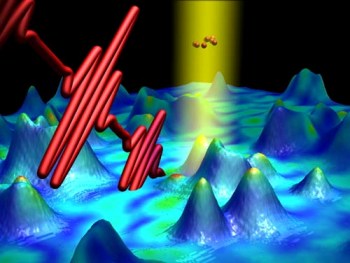Scientists from Würzburg, Kaiserslautern, and Bielefeld have introduced a unique advanced technology microscope that is capable of magnifying specimens a million times and captures the object’s movements with one million billion times retardation. The report of this new discovery was published in the magazine "Science".
 Ultra-short laser pulses (red) are used to measure electron oscillations (red balls) at the surface of a nano-structure. Photo: Walter Pfeiffer, Bielefeld University
Ultra-short laser pulses (red) are used to measure electron oscillations (red balls) at the surface of a nano-structure. Photo: Walter Pfeiffer, Bielefeld University
This new microscopy method enables monitoring of very quick processes occurring in minute objects by featuring unmatched temporal and spatial resolution. Tobias Brixner, Professor of the Institute for Physical and Theoretical Chemistry of the University of Würzburg, stated that the research team was able to measure the electron oscillations’ duration taking place in an individual nanostructure.
The analyses report revealed that when a silver nanostructure was excited with light, its overall electron movement in specific places existed up to 20 times longer than expected. The period of electron oscillations is studied not only for fundamental research, but also has a considerable impact on the efficiency of the occurring energy-transport processes, for example, during the photosynthesis processes taking place in plants or in photovoltaic cells. According to the researcher, this new technology will help them to monitor very quick processes occurring in several artificial and natural nanostructured materials in the future.